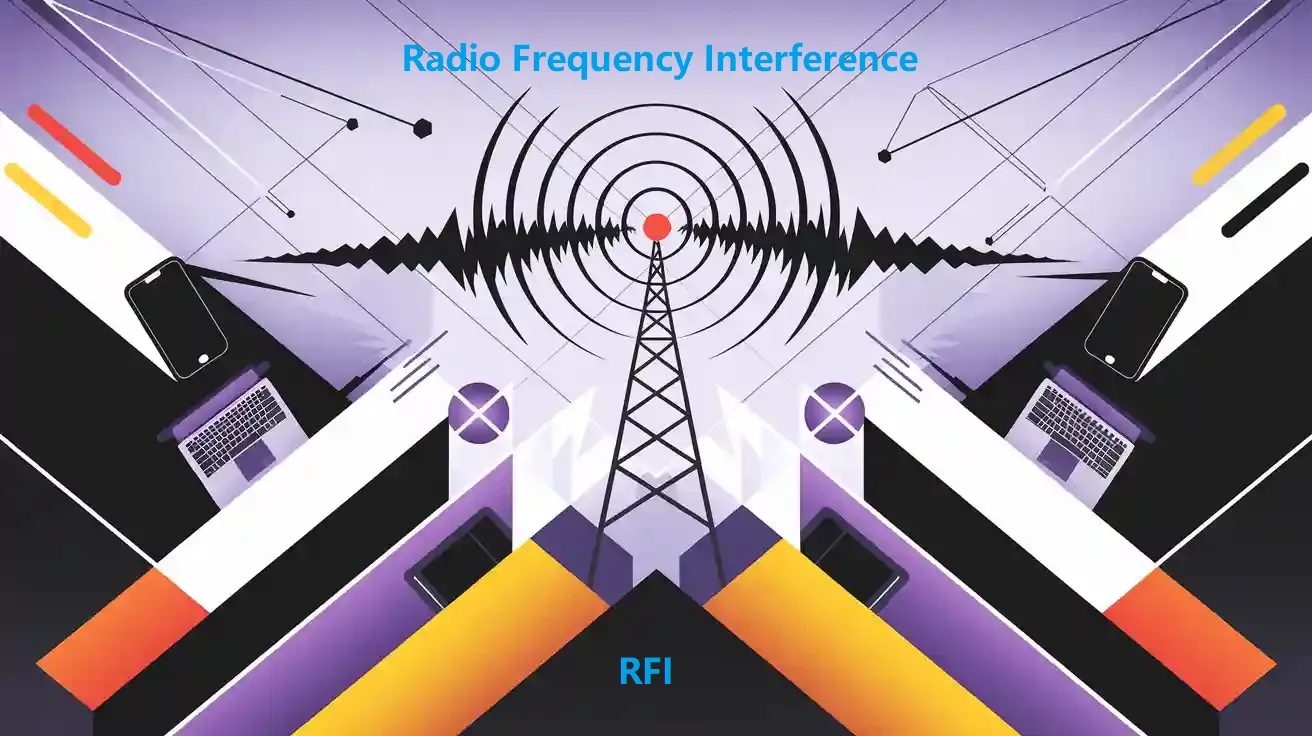📡 Key Takeaways
Radio Frequency Interference (RFI) disrupts wireless devices like phones and Wi-Fi by causing unwanted signals that lower performance and cause connection problems.
Common sources of RFI include household electronics, natural events like thunderstorms, and crowded urban environments with many devices, so knowing these helps you identify interference causes.
Using RFI filters, proper grounding, shielding, and smart device placement can reduce interference and keep your electronics working reliably even as new wireless technologies emerge.

📡 Introduction to Radio Frequency Interference
Radio Frequency Interference (RFI) is a type of electromagnetic interference (EMI) that occurs when unwanted radio frequency signals disrupt the normal operation of electronic or communication systems. These signals typically range from 10 kHz to 300 GHz and can originate from a variety of intentional or unintentional sources.
In Ethernet-based communication systems, RFI is a critical concern—especially in high-speed or industrial environments—where it can degrade signal quality, reduce data throughput, or even cause complete communication failure.
📡 What Causes RFI?
Radio Frequency Interference (RFI) is caused by unwanted radio signals from both natural and man-made sources. Key categories include:
☛ Industrial & Electrical Devices
Motors, fluorescent lights, microwave ovens
Switch-mode power supplies (SMPS)
Variable frequency drives (VFDs)
☛ Wireless Devices
Wi-Fi routers, Bluetooth, mobile phones
Devices operating in the 2.4 GHz and 5 GHz bands can interfere with each other
☛ Physical & Environmental Factors
Walls, buildings, and furniture block or reflect signals
Rain, fog, and trees can absorb or scatter high-frequency RF waves (especially above 10 GHz), potentially affecting wireless signals like 5G or satellite communication.
☛ Natural Sources
Natural sources like lightning and solar flares can generate broadband RF noise under extreme conditions, though their impact on everyday Ethernet systems is generally limited.
☛ Hardware & Design Issues
Unshielded cables, poor PCB layout
Corroded or poorly made connectors can introduce passive intermodulation (PIM), a nonlinear effect especially relevant in RF systems with high power or dense frequencies.
☛ Intentional & Unintentional Emitters
Two-way radios, RFID readers, monitors, CPUs
📡 How to Mitigate RFI (Radio Frequency Interference)
Mitigating RFI involves identifying the source, using filtering techniques, implementing grounding and shielding strategies, and applying best practices in Ethernet hardware and layout design.
Identifying RFI Sources
Accurate detection is the first step. Use tools like:
Spectrum Analyzers – visualize narrowband/broadband signals
Directional Antennas (e.g., Yagi) – trace signal direction
Real-time & Signature Analyzers – capture transient or repetitive interference
Mapping Tools – plot sources using GPS-based triangulation
Pro Tip: Tools like AirSleuth-Pro and RFeye Site are valuable for advanced RFI diagnostics.
RFI Filters and Suppression Techniques
RFI filters suppress high-frequency noise while passing intended signals. They are commonly used on:
Power Lines – to block conducted emissions
Signal Lines – to suppress differential and common-mode noise
Modern filters may include:
Miniaturized designs for compact devices
Hybrid filters combining passive and active suppression
Multi-stage filtering for power-dense industrial environments
Filters address both common-mode and differential-mode interference.
Ethernet-Specific RFI Mitigation
1. Shielded RJ45 Connectors
Metal-shielded RJ45 connectors prevent RF ingress/egress and protect signal integrity.
2. Integrated Magnetics (LAN Transformers)
LAN transformers isolate signal paths and suppress noise coupling into Ethernet PHY.
3. PCB Grounding & Layout
Use short return paths for high-frequency signals
Maintain solid ground planes under traces
Tie RJ45 shield tabs directly to chassis ground
4. Twisted-Pair Cabling
Use Shielded Twisted Pair (STP) in noisy environments
Ensure proper grounding of cable shields at both ends
Grounding, Shielding, and Device Placement
Grounding: Diverts interference safely to earth
Shielding: Blocks or reflects RF with enclosures (e.g., copper, aluminum)
Placement: Avoid locating sensitive devices near microwave ovens or cordless phones
Design Integration: Apply EMI/RFI shielding at the early design stage to reduce redesign cost
📡 RFI vs EMI: What's the Difference?
While RFI is often used interchangeably with EMI, they are not exactly the same. Both terms describe unwanted energy that disrupts electronic systems, but they focus on different frequency ranges and sources. RFI radio frequency interference is a subset of EMI, specifically dealing with radio frequencies used for wireless communication. Emi covers a broader range, including low-frequency and high-frequency disturbances.
Aspect | Radio Frequency Interference (RFI) | Electromagnetic Interference (EMI) |
|---|---|---|
Frequency Range | Radio frequency bands (radio waves, microwaves) | Broad range, from low to high frequencies |
Typical Sources | Wi-Fi routers, mobile phones, Bluetooth, unshielded devices | Motors, generators, power lines, lightning, solar flares |
Nature | Subset of EMI, mainly radiated in RF spectrum | Includes conducted, inductive, capacitive, and radiated EMI |
Impact | Disrupts wireless systems, affects communication devices | Causes noise, voltage drops, and interference in many systems |
📡 Applications that Demand RFI Immunity
Industrial Ethernet switches
Medical devices with network interfaces
Outdoor or automotive Ethernet systems
PoE surveillance systems
Embedded systems with sensitive PHYs
LINK-PP offers a wide range of RJ45 connectors with integrated magnetics that are engineered to meet the EMI/RFI performance demands of IEEE 802.3-compliant systems.
📡 Conclusion
Radio Frequency Interference (RFI) poses a critical challenge in high-speed Ethernet and industrial communication systems. Severe RFI can degrade signal quality, reduce throughput, or in extreme cases, cause temporary communication failure.
Effective RFI mitigation demands a holistic approach—combining shielded connectors, high-quality LAN transformers, optimized PCB layout, and proper grounding.
Proactive design, thorough testing, and ongoing interference monitoring are essential to maintaining stable, EMI-resilient network infrastructure.
See Also
Understanding The Effects Of EMI Interference On Electronics
An Introduction To The Common Public Radio Interface CPRI
Exploring The Concept Of Electromagnetic Compatibility Explained


